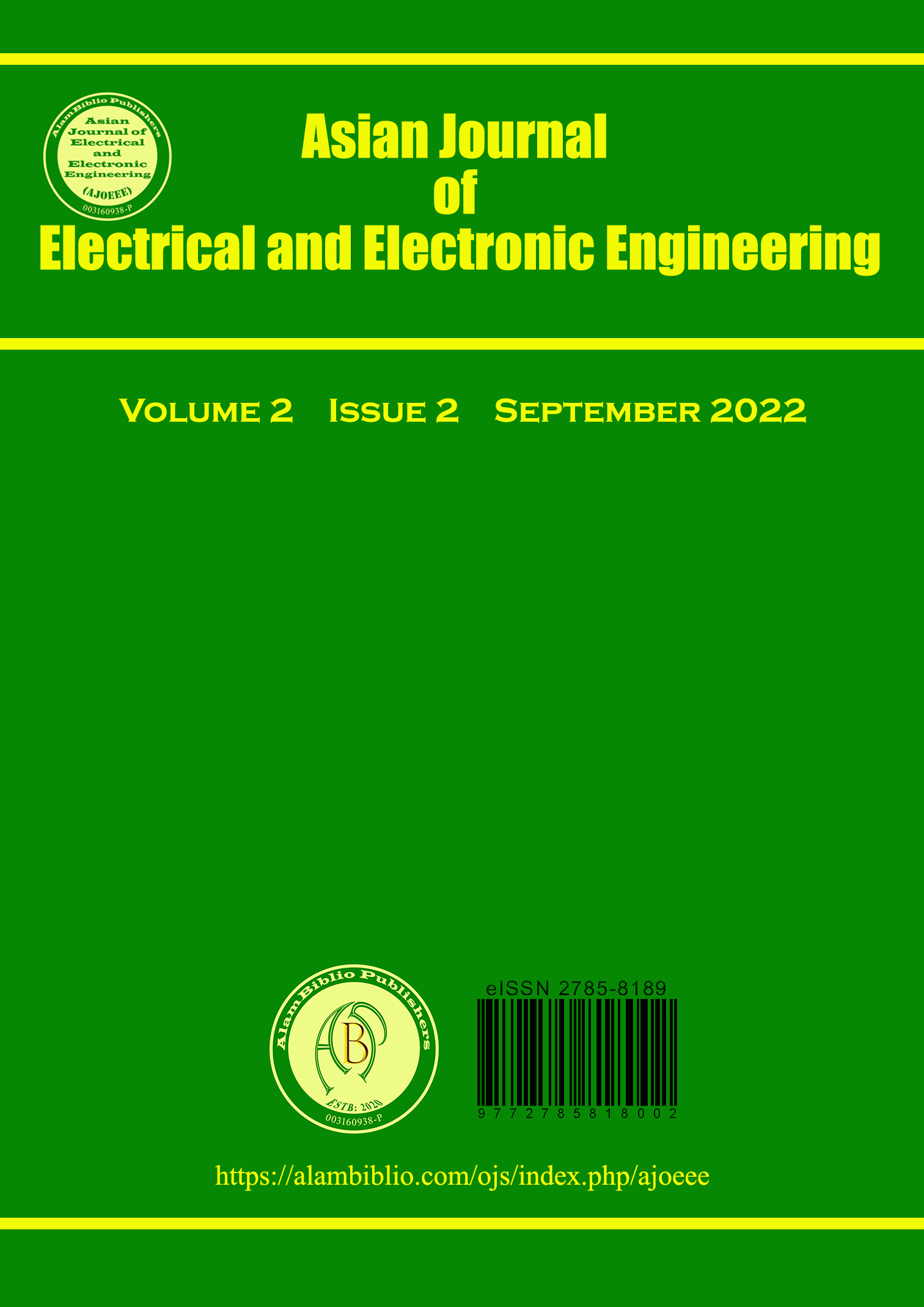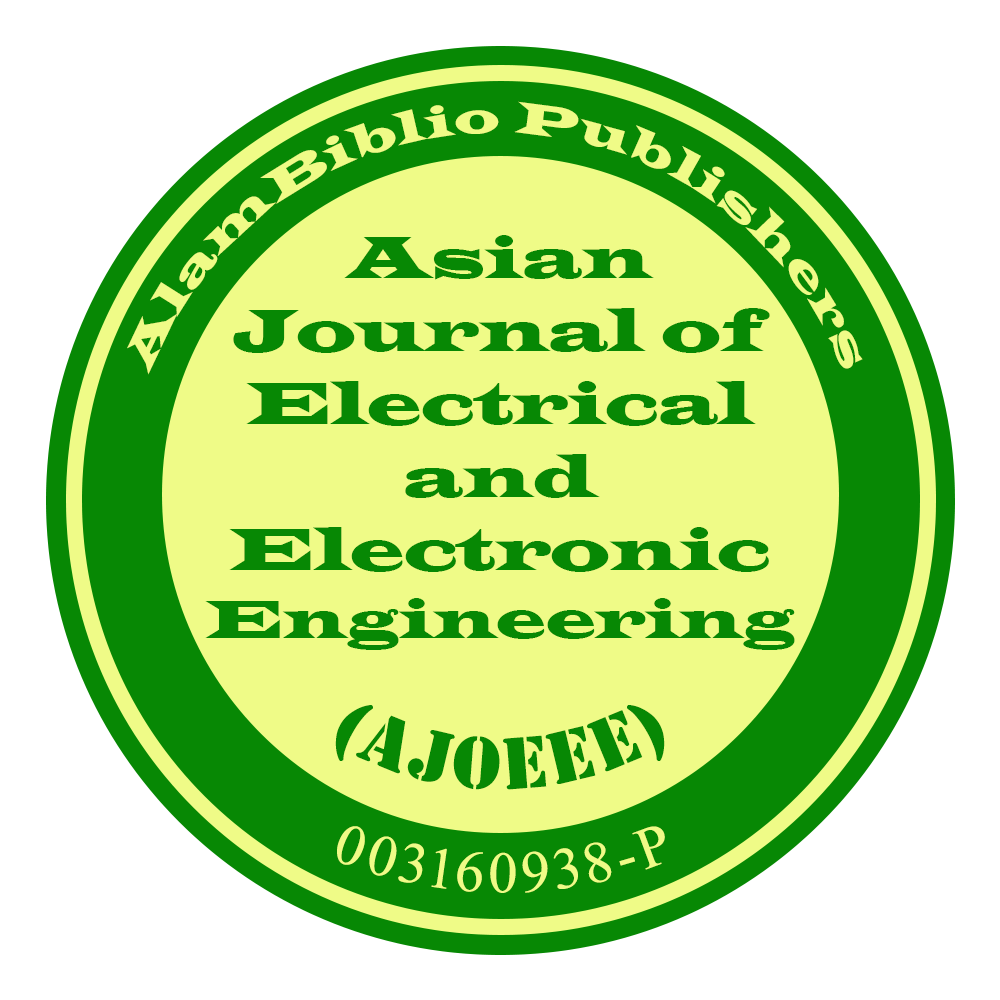Performance Analysis of a Hybrid Free Space Optics/ Visible Light Communication Systems
DOI:
https://doi.org/10.69955/ajoeee.2022.v2i2.35Keywords:
Free Space Optic (FSO), Visible light Communication (VLC), Atmospheric turbulence, Hybrid FSO/VLCAbstract
A hybrid free space optical (FSO)/visible light communication (VLC) system is a remarkable wireless technology for overcoming the last mile gap and for future broadband wireless communication. In detail, this research examines the hybrid FSO/VLC system performance using Optisystem 19 software. The system performance of the wireless hybrid FSO/VLC is evaluated using the bit error rate, quality factor, and eye diagram for weak and strong turbulence regimes referring to the Gamma-Gamma atmospheric turbulence channel. At BER of the maximum attainable distances are 1.3 km and 1.8 km for 0 dBm and 5 dBm transmitted power in clear weather, respectively. However, when the transmit power reduces to -5 dBm, the measured BER drops to 8×10-3 with a distance of 1 km link range. Moreover, when the power increases from 0 dBm to 5 dBm, the distance of the connection between Tx and Rx can be extended from 1.1 km and 1.9 km under weak turbulence conditions at the target BER of 10-9. In contrast, at the same target of BER, only 5 dBm of transmitted power managed to capture the signal at a distance of 1.7 km for strong turbulence conditions. This result can be the benchmark research to investigate and identify the best strategies for validating future experimentation difficulties.
Downloads
References
Cisco, "Cisco: 2020 Annual Internet Report," Computer Fraud & Security, 2020.
M. Z. Chowdhury, M. K. Hasan, M. Shahjalal, M. T. Hossan, and Y. M. Jang, "Optical Wireless Hybrid Networks: Trends, Opportunities, Challenges, and Research Directions," IEEE Communications Surveys and Tutorials, pp. 930–966, Apr. 2020. https://doi.org/10.1109/COMST.2020.2966855 DOI: https://doi.org/10.1109/COMST.2020.2966855
P. Pesek, S. Zvanovec, P. Chvojka, Z. Ghassemlooy, and P. A. Haigh, "Demonstration of a hybrid FSO/VLC link for the last mile and last meter networks," IEEE Photonics Journal, 2019. https://doi.org/10.1109/JPHOT.2018.2886645 DOI: https://doi.org/10.1109/JPHOT.2018.2886645
N. A. and S. Siti Hajar Ab Aziz, "Performance Analysis of Free Space Optics Link Under the Effect of Rain Attenuation," 2021.
L. Cang, H. K. Zhao, and G. X. Zheng, "The Impact of Atmospheric Turbulence on Terahertz Communication," IEEE Access, vol. 7, pp. 88685–88692, 2019. https://doi.org/10.1109/ACCESS.2019.2925815 DOI: https://doi.org/10.1109/ACCESS.2019.2925815
N. A. M. Nor, et al., "Experimental all-optical relay-assisted FSO link with regeneration and forward scheme for ultra-short pulse transmission," Optics Express,p. 22127, 2019. https://doi.org/10.1364/OE.27.022127 DOI: https://doi.org/10.1364/OE.27.022127
N. A. M. Nor et al., "Experimental investigation of all-optical relay-assisted 10Gb/s FSO link over the atmospheric turbulence channel," Journal of Lightwave Technology, pp. 45–53, Jan. 2017. https://doi.org/10.1109/JLT.2016.2629081 DOI: https://doi.org/10.1109/JLT.2016.2629081
Z. Huang et al., "Hybrid optical wireless network for future SAGO-integrated communication based on FSO/VLC heterogeneous interconnection," IEEE Photonics Journal, pp. 1–10, 2017. https://doi.org/10.1109/JPHOT.2017.2655004 DOI: https://doi.org/10.1109/JPHOT.2017.2655004
X. Li, Z. Ghassemlooy, S. Zvanovec, R. Perez-Jimenez, and P. A. Haigh, "Should Analogue Pre-Equalizers be Avoided in VLC Systems?," IEEE Photonics Journal, pp. 1–14, 2020. https://doi.org/10.1109/JPHOT.2020.2966875 DOI: https://doi.org/10.1109/JPHOT.2020.2966875
I. E. Lee et al., "Design of a hybrid free space optical and visible light communication system for indoor wireless data broadcasting," Journal of Physics: Conference Series, vol. 1432, no. 1, 2020. https://doi.org/10.1088/1742-6596/1432/1/012065 DOI: https://doi.org/10.1088/1742-6596/1432/1/012065
S. R. Teli, S. Zvanovec, and Z. Ghassemlooy, "Optical internet of things within 5g: Applications and challenges," Proceedings - 2018 IEEE International Conference on Internet of Things and Intelligence System, IOTAIS 2018, pp. 40–45, 2019. https://doi.org/10.1109/IOTAIS.2018.8600894 DOI: https://doi.org/10.1109/IOTAIS.2018.8600894
B. G. Guzman et al., "Reflection-based relaying techniques in visible light communications: Will it work?," IEEE Access, pp. 80922–80935, 2020. https://doi.org/10.1109/ACCESS.2020.2990660 DOI: https://doi.org/10.1109/ACCESS.2020.2990660
Z. Zheng, L. Liu, T. Chen, and W. Hu, "Integrated system of free-space optical and visible light communication for indoor wireless broadband access," Electronics Letters, pp. 1943–1944, 2015. https://doi.org/10.1049/el.2015.2648 DOI: https://doi.org/10.1049/el.2015.2648
N. S. Sadzali, N. A. M. Nor, and S. H. B. A. Aziz, "Performance Analysis of FSO Systems using Different Modulation Techniques under the Influence of Atmospheric Turbulence," pp. 397–400, 2021. https://doi.org/10.1109/ICCCE50029.2021.9467218 DOI: https://doi.org/10.1109/ICCCE50029.2021.9467218
O. O. Semiconductors, "Golden DRAGON Datasheet Version," pp. 1–21, 2016.
S. Burdah et al., "Performance analysis of Q factor optical communication in free space optics and single mode fiber," Universal Journal of Electrical and Electronic Engineering, pp. 167–175, 2019. https://doi.org/10.13189/ujeee.2019.060311 DOI: https://doi.org/10.13189/ujeee.2019.060311
N. A. M. Nor et al., "10 Gbps all-optical relay-assisted FSO system over a turbulence channel," 2015 4th International Workshop on Optical Wireless Communications, IWOW 2015, no. September, pp. 69–72, 2015.
Downloads
Published
Issue
Section
License
Copyright (c) 2022 AlamBiblilo Publishers

This work is licensed under a Creative Commons Attribution-NonCommercial 4.0 International License.
The Asian Journal of Electrical and Electronic Engineering journal is licensed under a Creative Commons Attribution-NonCommercial 4.0 International License.










